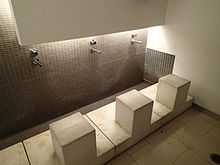
Back طقوس الطهارة Arabic আত্মশুদ্ধি Bengali/Bangla Purificació (religió) Catalan Rituální čistota Czech Rituelle Reinheit German Purificación (religión) Spanish آیین طهارت Persian Rituaalinen puhtaus Finnish דרכי היטהרות מטומאה HE Rituális fürdés Hungarian
This article needs additional citations for verification. (November 2019) |


Ritual purification is a ritual prescribed by a religion through which a person is considered to be freed of uncleanliness, especially prior to the worship of a deity, and ritual purity is a state of ritual cleanliness. Ritual purification may also apply to objects and places. Ritual uncleanliness is not identical with ordinary physical impurity, such as dirt stains; nevertheless, body fluids are generally considered ritually unclean.
Most of these rituals existed long before the germ theory of disease, and figure prominently from the earliest known religious systems of the Ancient Near East. Some writers connect the rituals to taboos.
Some have seen benefits of these practices as a point of health and preventing infections especially in areas where humans come in close contact with each other. While these practices came before the idea of the germ theory was public in areas that use daily cleaning, the destruction of infectious agents seems to be dramatic.[dubious – discuss][1] Others have described a 'dimension of purity' that is universal in religions that seeks to move humans away from disgust (at one extreme), to uplift them towards purity and divinity (at the other extreme), away from uncleanliness to purity, and away from deviant to moral behavior (within one's cultural context).[2]
- ^ "Nitten Soji and the prevention of infections" Classical fighting arts vol 2 #18
- ^ Haidt, Johnathan (12 February 2010). The Happiness Hypothesis. Basic Books.